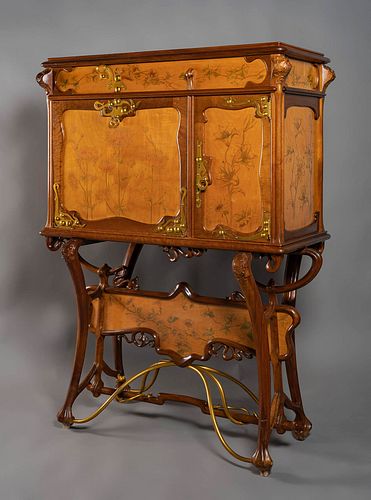JOAN BUSQUETS I JANÉ (Barcelona, 1874-1949). Modernist cabinet, ca. 1898. Walnut wood structure with golden polychrome and pyrography. Keyholes, handl
Lot 103
About Seller
Setdart Auction House
Carrer Aragó 346
Barcelona
Spain
Setdart Subastas was born in 2004 and is currently the first online art auction in Spain with solidity, prestige and reliability guaranteed by our more than 60,000 users. Setdart has a young, dynamic and enterprising team ready to successfully manage the purchase and sale of art works through custom...Read more
Categories
Estimate:
$25,000 - $30,000
Absentee vs Live bid
Two ways to bid:
- Leave a max absentee bid and the platform will bid on your behalf up to your maximum bid during the live auction.
- Bid live during the auction and your bids will be submitted real-time to the auctioneer.
Bid Increments
| Price | Bid Increment |
|---|---|
| $0 | $10 |
| $200 | $25 |
| $500 | $50 |
| $1,000 | $100 |
| $3,000 | $200 |
| $5,000 | $500 |
| $10,000 | $1,000 |
| $20,000 | $2,000 |
| $50,000 | $5,000 |
About Auction
By Setdart Auction House
Jun 17, 2021
Set Reminder
2021-06-17 06:15:00
2021-06-17 06:15:00
America/New_York
Bidsquare
Bidsquare : 19th & 20th Century Contemporary Art - Select Lots
https://www.bidsquare.com/auctions/setdart-auction-house/19th-20th-century-contemporary-art---select-lots-7081
Setdart Auction House sofia@setdart.com
Setdart Auction House sofia@setdart.com
- Lot Description
JOAN BUSQUETS I JANÉ (Barcelona, 1874-1949). Modernist cabinet, ca. 1898. Walnut wood structure with golden polychrome and pyrography. Keyholes, handles and decorative appliques in golden brass. Signed on the front in the lower left corner of the right door. Work reproduced on the cover and in color in the book “La casa Busquets. A history of furniture and decoration from modernism to déco in Barcelona ”, Teresa M. Sala, p. 315. Origin: Villa Adauta in La Garriga. Measurements: 165 x 116 x 60 cm. Modernist cabinet designed by Joan Busquets and made of walnut wood with polychrome and fine gold, decorated with pyrography, the keyholes, handles and decorative fixtures are made of gilded brass. The structure of the cabinet has a lower area with a cut-out base, raised on four stylized legs, with a perpendicularly placed tabletop, with totally sinuous forms, providing dynamism and originality to the design. The upper area has a double opening, both with hinged doors, one from top to bottom opening as a desk and the other from left to right. The interior zone is resolved by means of several drawers of different sizes, and above them we see a shortcut or open hole. The entire body of the piece of furniture is richly decorated with typically modernist stylized vegetal motifs, made with the pyrography technique, framed by sinuous moldings in relief. In short, this is a first class piece of furniture within Catalan modernism, given that it was produced by one of the best workshops of the time, as well as for the perfection and meticulousness with which each of its details have been made. Busquets y Jané introduced for the first time the new technique of polychrome pyrography replacing marquetry in 1898, being contemporary to the cabinet we present, dated 1898. He, besides being a designer and decorative artist, applied pyrography personally on the furniture he had previously designed, so he was actively involved in its realization. This technique was a characteristic element of what is known as the "Busquets style". Furniture designer and decorator, Joan Busquets is currently considered one of the most representative figures of Catalan modernism. He began his training in the family workshop, and then studied at the Escuela de La Llotja in Barcelona, where his teachers were Guitart and Lostaló. In the 1895-96 academic year he obtained a scholarship that allowed him to travel around Spain, which he obtained thanks to a project for a Renaissance-style bookcase-cabinet. He exhibited furniture projects for the first time at the Barcelona Exhibition of 1896. The workshop of Joan Busquets was one of the most outstanding of modernist Catalonia and is currently, together with the production of Gaspar Homar, the most representative testimony of the furniture and decoration of Catalan modernism. He was president of the Fomento de las Artes Decorativas between 1918 and 1921, and supervised the manufacture of furniture for Gaudí's Casa Calvet. Works by Busquets can currently be found in the National Art Museum of Catalonia, the Güell Palace in Barcelona, the National Museum of Decorative Arts and the Museum of Catalan Modernism in Barcelona, among others, as well as in several important private collections.
- Shipping Info
-
In-house shipping available. Please inquire at admin@setdart.com.
-
- Buyer's Premium



 EUR
EUR CAD
CAD AUD
AUD GBP
GBP MXN
MXN HKD
HKD CNY
CNY MYR
MYR SEK
SEK SGD
SGD CHF
CHF THB
THB


















